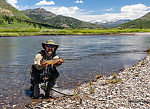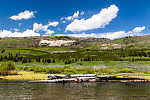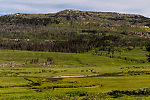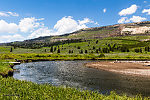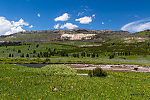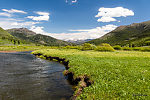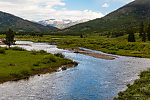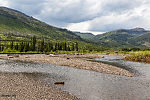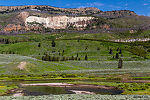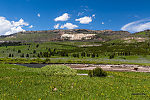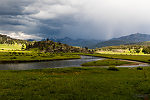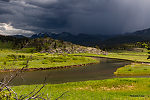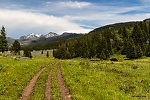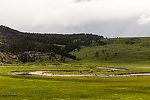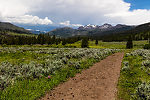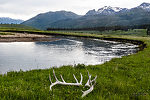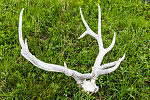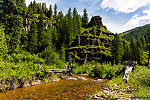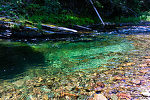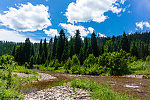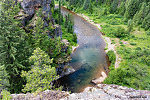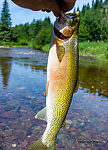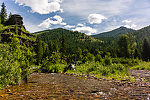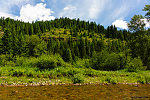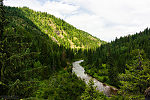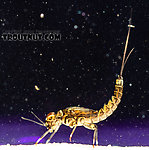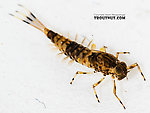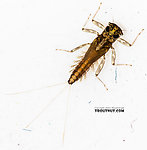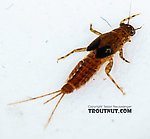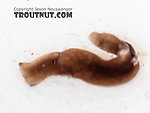Blog & Latest Updates
Fly Fishing Articles
Insects by Common Name


Latest updates, page 15
First full day on Slough Creek - June 27, 2019
Knowing that early morning was unlikely to be very productive during runoff, we took advantage of the cool morning weather to hike five miles farther up the trail to the Upper Slough Creek campground, where we would stay for the next two nights. We made good time and were on the water there near noon.
We soon realized that the slow action at the end of the previous night was not caused by the storm, but was instead the norm. Most pools produced no strikes, and when there was action, there were frequently several fish in the same place that didn't seem like an especially spectacular holding lie. As we walked upstream along a deep riffle, everything quickly began to make sense: many of the fish were still spawning in the riffles or staging nearby. Fish actively spawning or on their redds steadfastly ignored all sorts of flies, but those staging, moving through, or involved in territorial disputes were more willing.
I landed the first fish of the day, which was also my first sizable Yellowstone Cutthroat:
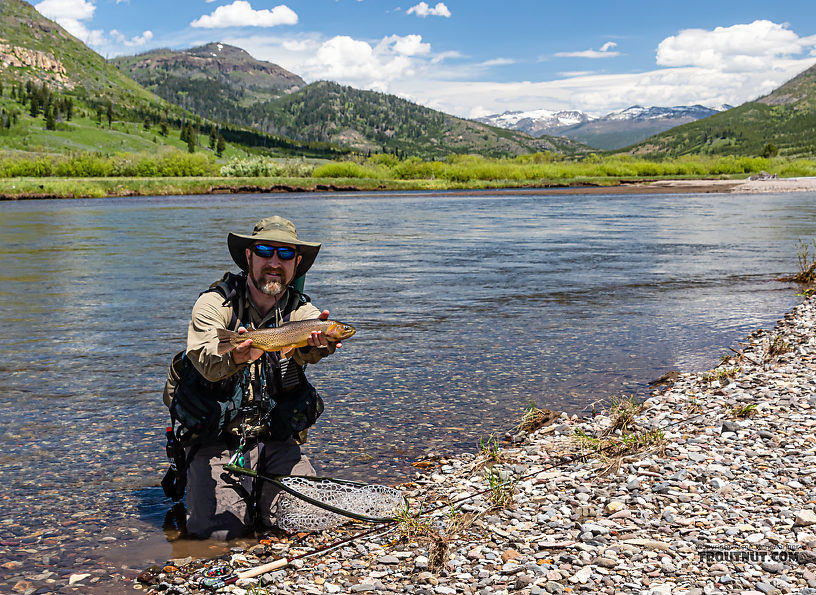
It certainly helped that we had figured out what the fish were up to, but it was still tricky fishing: most riffles, like most pools, were devoid of fish, and increasing cloud cover made spotting them in the riffles more and more difficult as the day went on. I tried a variety of big, articulated streamers, mostly with the rear hook clipped off to comply with Yellowstone's single-hook rule. The fish were striking short and I missed the vast majority of my opportunities because they didn't get the hook; apparently this is a common behavior of Yellowstone Cutthroat. My friend was doing much better with a Sculpzilla (or "Godzilla Sculpin" as it was termed by the trademark-sensitive fly company), which has as its only hook a stinger located as far toward the back of the fly as possible.
After missing a ridiculous number of fish, I finally got the memo and switched to a Sculpzilla myself, which would be the go-to fly for the rest of the trip. In the future I'll carry a greater variety of streamers with far-back stinger hooks for such situations. I ended up landing four good fish for the day after covering a few miles of water; my friend caught well over twice that, having used the right fly in the first place. Most fish were associated with spawning habitat but not actively spawning, but a few came from more typically promising pools as well.
Despite some early frustration with my flies, the day was awesome, fishing in solitude through wide-open meadows rimmed by snow-capped peaks and dotted with the occasional bison, elk, deer, and the first badger either one of us had seen close-up in the wild.
We soon realized that the slow action at the end of the previous night was not caused by the storm, but was instead the norm. Most pools produced no strikes, and when there was action, there were frequently several fish in the same place that didn't seem like an especially spectacular holding lie. As we walked upstream along a deep riffle, everything quickly began to make sense: many of the fish were still spawning in the riffles or staging nearby. Fish actively spawning or on their redds steadfastly ignored all sorts of flies, but those staging, moving through, or involved in territorial disputes were more willing.
I landed the first fish of the day, which was also my first sizable Yellowstone Cutthroat:

It certainly helped that we had figured out what the fish were up to, but it was still tricky fishing: most riffles, like most pools, were devoid of fish, and increasing cloud cover made spotting them in the riffles more and more difficult as the day went on. I tried a variety of big, articulated streamers, mostly with the rear hook clipped off to comply with Yellowstone's single-hook rule. The fish were striking short and I missed the vast majority of my opportunities because they didn't get the hook; apparently this is a common behavior of Yellowstone Cutthroat. My friend was doing much better with a Sculpzilla (or "Godzilla Sculpin" as it was termed by the trademark-sensitive fly company), which has as its only hook a stinger located as far toward the back of the fly as possible.
After missing a ridiculous number of fish, I finally got the memo and switched to a Sculpzilla myself, which would be the go-to fly for the rest of the trip. In the future I'll carry a greater variety of streamers with far-back stinger hooks for such situations. I ended up landing four good fish for the day after covering a few miles of water; my friend caught well over twice that, having used the right fly in the first place. Most fish were associated with spawning habitat but not actively spawning, but a few came from more typically promising pools as well.
Despite some early frustration with my flies, the day was awesome, fishing in solitude through wide-open meadows rimmed by snow-capped peaks and dotted with the occasional bison, elk, deer, and the first badger either one of us had seen close-up in the wild.
Photos by Troutnut from Slough Creek in Wyoming
Hiking in to Slough Creek -- June 26, 2019
Our trip up Slough Creek began at the crowded trailhead with a single parking space open. We walked up the road far enough to verify that the creek was in fishable shape, because we were still prepared to leave and move to a mountain lake as a backup plan if needed. The water was still high from snowmelt runoff, but it was reasonably clear and looked inviting anyway.
The beginning of the trail climbs over a small ridge before dropping down to the river at the downstream end of a large meadow a mile and a half from the trailhead. We passed many day hikers coming back down this trail, some with fishing rods and disappointed looks on their faces. As we arrived at the river, a thunderstorm was narrowly missing us to the northwest, keeping the lightning at a safe distance but casting enough clouds overhead to prompt an emergence of small blue-winged olives (Baetidae) in a large, slow eddy where the trail first meets the river. Several small trout were rising, and we snuck up and caught a few.
We continued up to the trail to set up camp at the Hornaday Creek campground, 5 miles from the trailhead. We had it all to ourselves, an upside to the park's system of camping by reservation only. In fact, we saw very few other people beyond the first couple miles of the trail at all, and no other anglers on the water. The creek is clearly less popular during runoff than it is a few weeks later when it drops, clears, and becomes a prime dry fly destination, which might be why I was able to get a camping permit at all.
We still had time for some evening fishing and hiked down to the river below camp. At the first pool we came to, we missed several strikes and lost a couple good fish on streamers, but none were landed. This seemed to bode extremely well for the rest of the trip, but when we moved up to new pools the action subsided. Another nasty storm was rolling in and chased us back to camp; at the time, we blamed the storm for the inaction in the other pools.
The beginning of the trail climbs over a small ridge before dropping down to the river at the downstream end of a large meadow a mile and a half from the trailhead. We passed many day hikers coming back down this trail, some with fishing rods and disappointed looks on their faces. As we arrived at the river, a thunderstorm was narrowly missing us to the northwest, keeping the lightning at a safe distance but casting enough clouds overhead to prompt an emergence of small blue-winged olives (Baetidae) in a large, slow eddy where the trail first meets the river. Several small trout were rising, and we snuck up and caught a few.
We continued up to the trail to set up camp at the Hornaday Creek campground, 5 miles from the trailhead. We had it all to ourselves, an upside to the park's system of camping by reservation only. In fact, we saw very few other people beyond the first couple miles of the trail at all, and no other anglers on the water. The creek is clearly less popular during runoff than it is a few weeks later when it drops, clears, and becomes a prime dry fly destination, which might be why I was able to get a camping permit at all.
We still had time for some evening fishing and hiked down to the river below camp. At the first pool we came to, we missed several strikes and lost a couple good fish on streamers, but none were landed. This seemed to bode extremely well for the rest of the trip, but when we moved up to new pools the action subsided. Another nasty storm was rolling in and chased us back to camp; at the time, we blamed the storm for the inaction in the other pools.
Photos by Troutnut from Slough Creek in Wyoming
Quick morning on the North Fork Couer d'Alene (CDA) River
I left Seattle in the evening on June 24th with a friend who had flown down from Alaska to join me on a Montana trip, and we drove late into the night to camp along the NF CDA and be ready to fish in the morning as a break in the long drive to Montana. We didn't get to sleep until around 2am, but we still got up fairly early (for me, that's 8am) and hit the water. We fished through a few good pools before any fish stirred, and the action gradually heated up throughout the morning. The campground host later laughed at our early start and verified that it's generally not worth being out there until the sun heats the water at that time of year.
No really big fish showed themselves, but there was fine action on small to mid-sized Westslope Cutthroat, and it was only getting better when we had to tear ourselves away from the water at 2pm to complete the long drive to Yellowstone.
No really big fish showed themselves, but there was fine action on small to mid-sized Westslope Cutthroat, and it was only getting better when we had to tear ourselves away from the water at 2pm to complete the long drive to Yellowstone.
Photos by Troutnut from the North Fork Couer d'Alene River in Idaho
Closeup insects by Troutnut from the North Fork Couer d'Alene River in Idaho
Female Alloperla (Sallflies) Stonefly Adult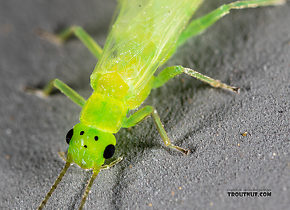 View 7 PicturesThese little green stoneflies were the most common bug on a June day fishing the North Fork Couer d'Alene, although the trout never rose more than sporadically to them or anything else.
View 7 PicturesThese little green stoneflies were the most common bug on a June day fishing the North Fork Couer d'Alene, although the trout never rose more than sporadically to them or anything else.
 View 7 PicturesThese little green stoneflies were the most common bug on a June day fishing the North Fork Couer d'Alene, although the trout never rose more than sporadically to them or anything else.
View 7 PicturesThese little green stoneflies were the most common bug on a June day fishing the North Fork Couer d'Alene, although the trout never rose more than sporadically to them or anything else.Collected June 25, 2019 from the North Fork Couer d'Alene River in Idaho
Added to Troutnut.com by Troutnut on July 17, 2019
Added to Troutnut.com by Troutnut on July 17, 2019
Pursuing Golden Trout with my Wife
This blog post is just a quick teaser for the long-form photo-journal I wrote about my favorite trip of last summer (2018), in which my wife and I backpacked into some high mountains for three days in pursuit of Golden Trout and had one of the prettiest places on Earth all to ourselves.
A few favorite images will serve as teasers for the full story:




Read it here.
Note: The bugs showing up below this post on the front page are only there because I uploaded them on the same day I posted the note about this story. They're from a different state and time of year.
A few favorite images will serve as teasers for the full story:




Read it here.
Note: The bugs showing up below this post on the front page are only there because I uploaded them on the same day I posted the note about this story. They're from a different state and time of year.
Closeup insects by Troutnut from the South Fork Snoqualmie River in Washington
Pictures and specimens from my 2018 Montana trip
I finally got around to uploading all the photos from a fishing & bug photography trip I took to Montana (and the surrounding area in Idaho and Wyoming) in August 2018. For the first ten days, I fished by myself from dawn to dusk, slept in my car, and got off the water only long enough to drive to the next fishing spot. It was a whirlwind tour of the famous waters of the West and many not-so-famous ones, sometimes stopping for just a few hours to wet a line in a river that takes a lifetime to master. I'll be back again to concentrate my efforts.
It might be a while (or never) before I have time to go through and narrate each day of the trip on the front page blog, so for now I'll just suggest browsing those posts and letting the pictures tell the story. Here are a few of my favorites:
The Firehole River, where cold mountain water meets hot geyers in what Ernest Schwiebert rightfully called "The Strangest Trout Stream on Earth."
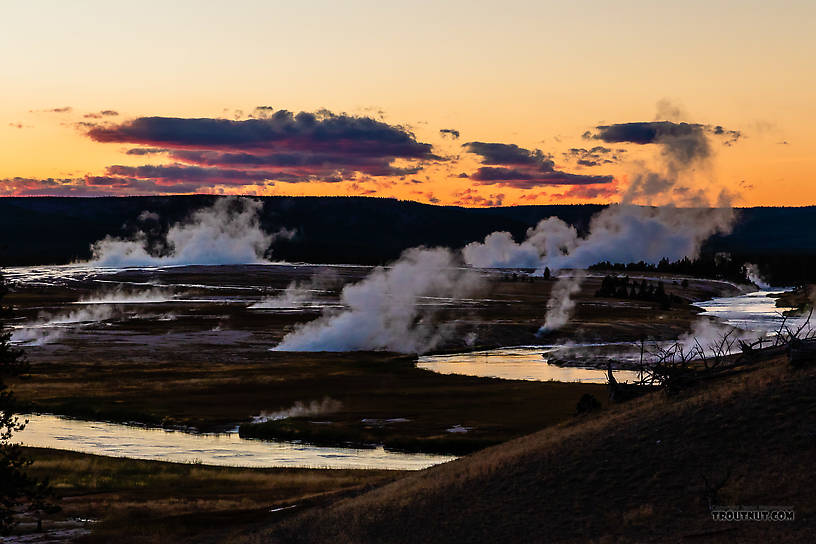
My biggest cutthroat trout to date, an 18-incher from a stream that shall not be named:
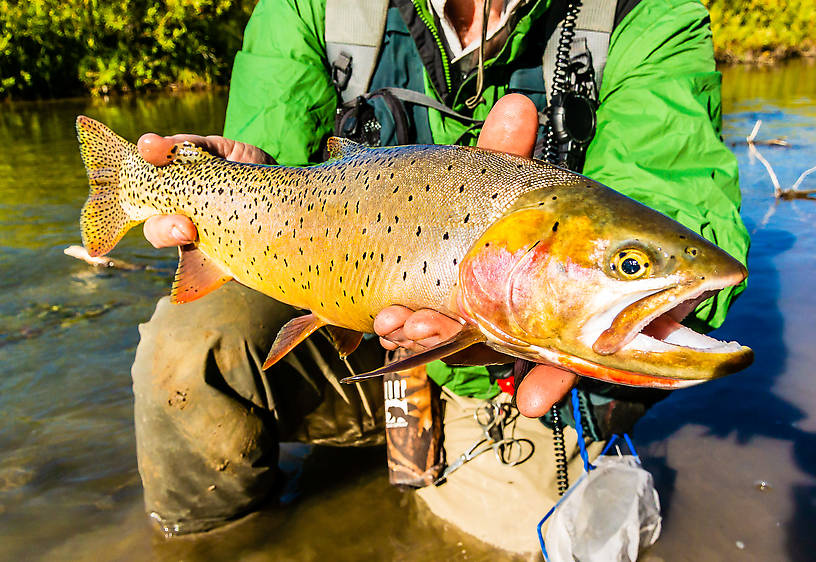
A herd of bison crossing the Yellowstone River:
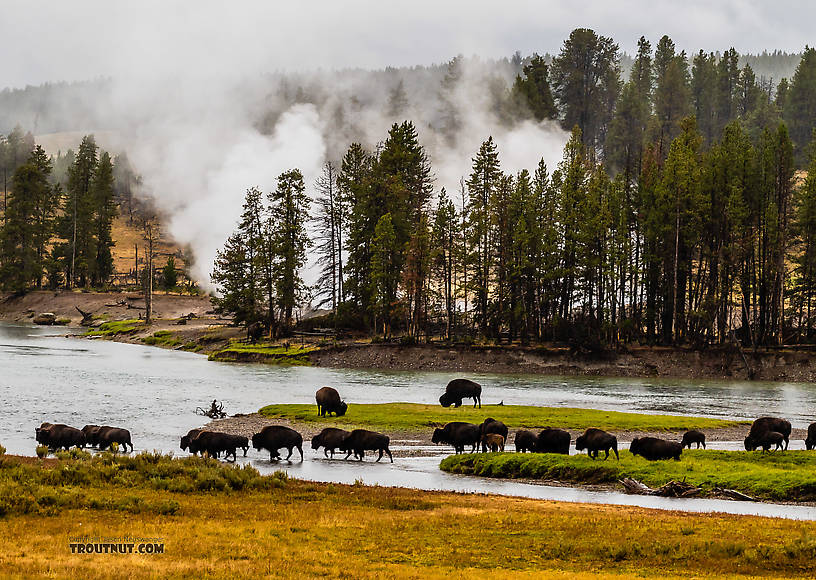
A Rock Creek cuttbow that put up one hell of a fight for its size:
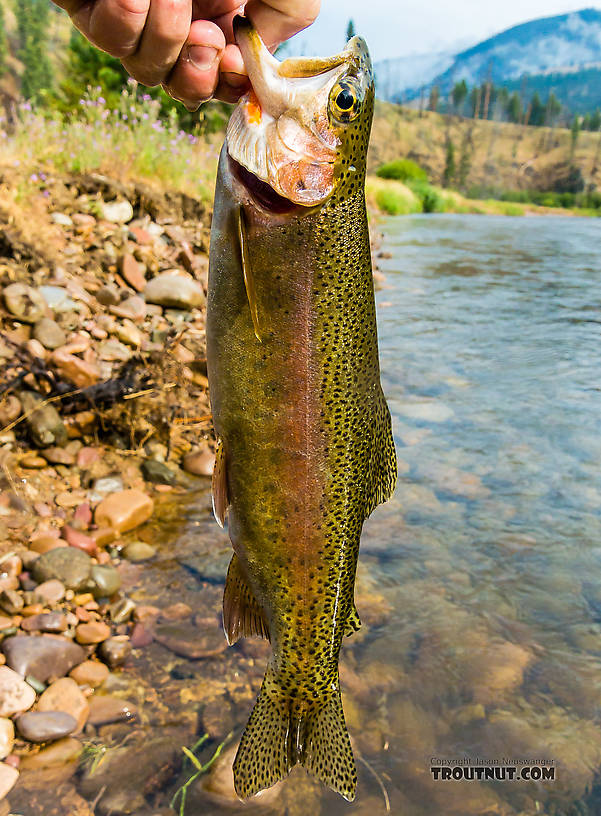
Another gorgeous cuttbow from a stream I'm keeping secret, this one with mostly "bow" and less "cutt":
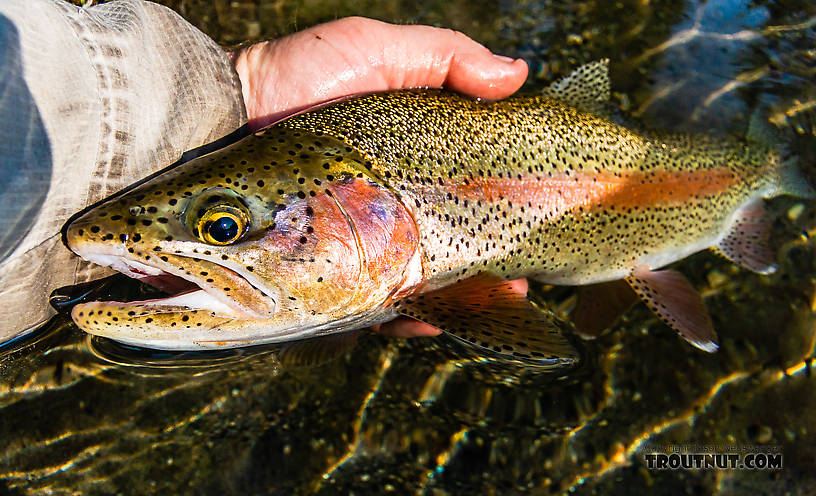
My personal best brook trout, fat and almost 16" long, from the same river:
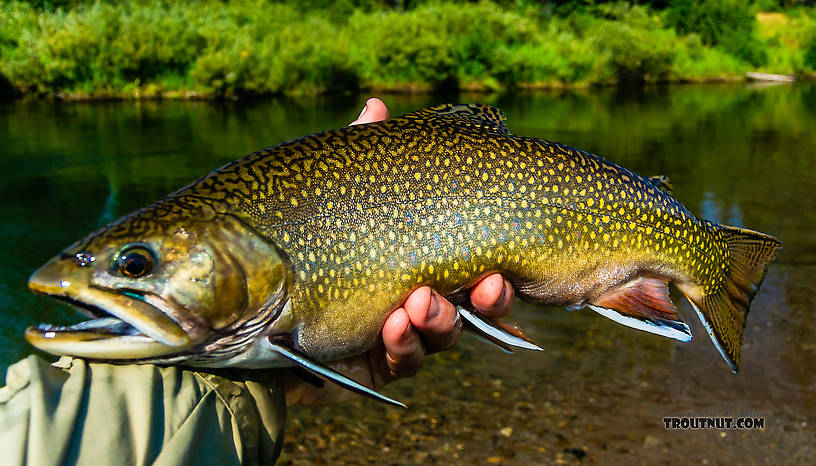
And a stately caddisfly from the Henry's Fork:
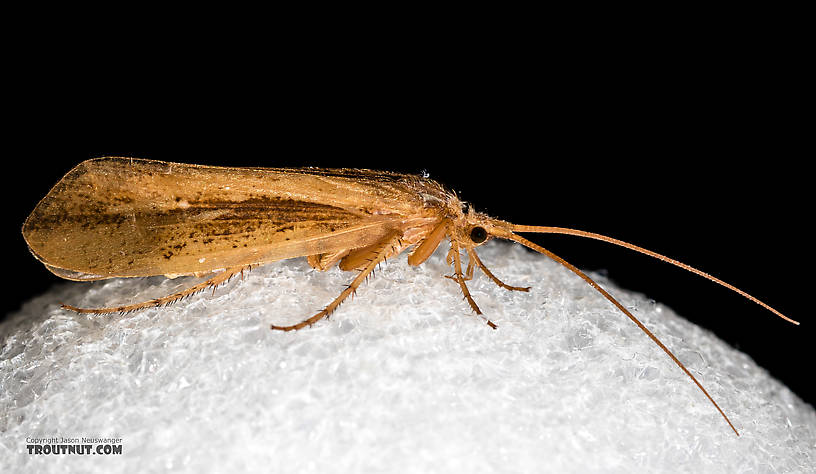
Enjoy!
It might be a while (or never) before I have time to go through and narrate each day of the trip on the front page blog, so for now I'll just suggest browsing those posts and letting the pictures tell the story. Here are a few of my favorites:
The Firehole River, where cold mountain water meets hot geyers in what Ernest Schwiebert rightfully called "The Strangest Trout Stream on Earth."

My biggest cutthroat trout to date, an 18-incher from a stream that shall not be named:

A herd of bison crossing the Yellowstone River:

A Rock Creek cuttbow that put up one hell of a fight for its size:

Another gorgeous cuttbow from a stream I'm keeping secret, this one with mostly "bow" and less "cutt":

My personal best brook trout, fat and almost 16" long, from the same river:

And a stately caddisfly from the Henry's Fork:

Enjoy!
Top 10 Fly Hatches
Top Gift Shop Designs
Eat mayflies.
Top Insect Specimens
Miscellaneous Sites
Troutnut.com is copyright © 2004-2024 Jason
Neuswanger (email Jason). See my FAQ for information about use of my images.
 privacy policy
privacy policy

